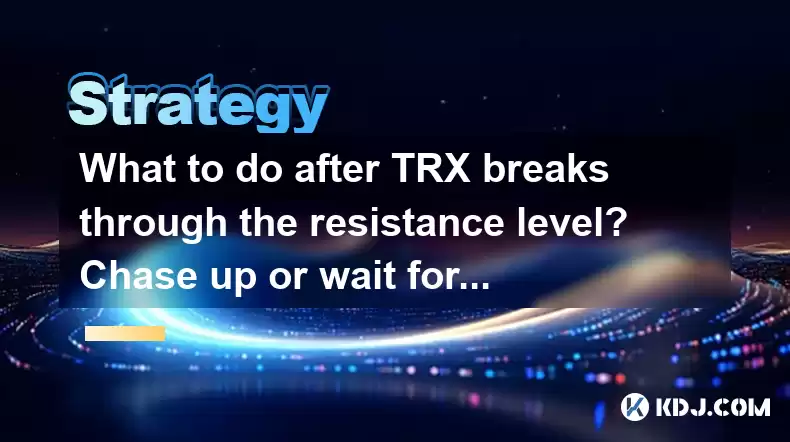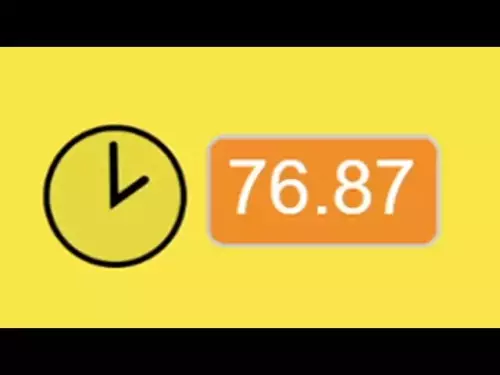-
 bitcoin
bitcoin $111743.690167 USD
0.54% -
 ethereum
ethereum $3950.699791 USD
0.55% -
 tether
tether $1.000164 USD
-0.01% -
 xrp
xrp $2.611685 USD
2.58% -
 bnb
bnb $1122.616845 USD
1.30% -
 solana
solana $193.462394 USD
-0.26% -
 usd-coin
usd-coin $0.999872 USD
-0.03% -
 dogecoin
dogecoin $0.196092 USD
-1.61% -
 tron
tron $0.296693 USD
-0.41% -
 cardano
cardano $0.652995 USD
-0.60% -
 hyperliquid
hyperliquid $44.316120 USD
12.98% -
 chainlink
chainlink $17.906269 USD
0.05% -
 ethena-usde
ethena-usde $0.999193 USD
-0.02% -
 stellar
stellar $0.326600 USD
1.70% -
 bitcoin-cash
bitcoin-cash $513.235984 USD
1.57%
What to do after TRX breaks through the resistance level? Chase up or wait for a callback?
After TRX breaks through resistance, traders must decide whether to chase the trend for immediate gains or wait for a callback to buy at a lower price, considering market sentiment and technical indicators.
Apr 29, 2025 at 11:29 am

After TRX breaks through a resistance level, traders face a crucial decision: whether to chase the upward trend or wait for a potential callback. This article will explore the strategies and considerations for both options, providing detailed insights to help you make an informed decision.
Understanding Resistance Breakthroughs
When TRX breaks through a resistance level, it signals a potential shift in market sentiment. Resistance levels are price points where selling pressure typically outweighs buying pressure, preventing the price from rising further. A breakthrough suggests that buyers have gained enough momentum to overcome this barrier, which can lead to further price increases.
To determine if a breakthrough is genuine, traders should look for confirmation signals. These can include increased trading volume, a sustained move above the resistance level, and positive momentum indicators. Without these signals, the breakthrough might be a false one, leading to a quick reversal.
Chasing the Upward Trend
Chasing the upward trend after a resistance breakthrough involves buying TRX immediately to capitalize on the momentum. This strategy is based on the belief that the price will continue to rise after breaking through the resistance.
- Pros of Chasing the Trend: The primary advantage is the potential for immediate gains. If the breakthrough is part of a strong bullish trend, early entry can lead to significant profits.
- Cons of Chasing the Trend: The main risk is buying at a peak, especially if the breakthrough is short-lived. This can result in losses if the price quickly reverses.
To implement this strategy, traders should:
- Monitor Real-Time Data: Use trading platforms that provide real-time price and volume data to identify the breakthrough as soon as it happens.
- Set Entry Points: Determine specific price levels at which you will enter the market, ensuring you do not chase the price too high.
- Use Stop-Loss Orders: Protect your investment by setting stop-loss orders at strategic levels to limit potential losses if the price reverses.
Waiting for a Callback
Waiting for a callback after a resistance breakthrough involves holding off on buying TRX until the price retraces to a more favorable level. This strategy is based on the expectation that the price will temporarily pull back before continuing its upward trend.
- Pros of Waiting for a Callback: This approach allows you to buy at a lower price, reducing the risk of entering at a peak. It can also provide a clearer entry point with less immediate risk.
- Cons of Waiting for a Callback: The main disadvantage is missing out on potential gains if the price continues to rise without a significant pullback.
To implement this strategy, traders should:
- Identify Support Levels: Use technical analysis to identify potential support levels where the price might retrace to.
- Set Alert Levels: Set price alerts at these support levels to notify you when the price reaches a favorable entry point.
- Monitor Market Sentiment: Keep an eye on market sentiment and news that could influence TRX's price movement, adjusting your strategy accordingly.
Technical Analysis for Decision Making
Technical analysis plays a crucial role in deciding whether to chase the trend or wait for a callback. Key indicators to consider include:
- Moving Averages: The relationship between short-term and long-term moving averages can signal the strength of the trend. A bullish crossover, where the short-term moving average crosses above the long-term moving average, can support a decision to chase the trend.
- Relative Strength Index (RSI): An RSI above 70 might indicate overbought conditions, suggesting a potential callback. Conversely, an RSI below 30 could signal an oversold condition, supporting a chase strategy.
- Volume: High volume during a breakthrough confirms strong buyer interest, supporting a chase strategy. Low volume might indicate a weak breakthrough, favoring a wait for a callback.
Risk Management Strategies
Regardless of the chosen strategy, risk management is essential to protect your investment. Key risk management techniques include:
- Position Sizing: Determine the size of your TRX position based on your overall portfolio and risk tolerance. Smaller positions can reduce the impact of potential losses.
- Diversification: Spread your investments across different cryptocurrencies to mitigate risk. Do not put all your funds into TRX alone.
- Stop-Loss Orders: Use stop-loss orders to automatically sell TRX if the price falls to a predetermined level, limiting potential losses.
- Take-Profit Orders: Set take-profit orders to lock in gains if the price reaches a target level, ensuring you do not miss out on potential profits.
Psychological Considerations
Psychological factors can significantly influence your decision to chase the trend or wait for a callback. It's important to:
- Avoid FOMO (Fear of Missing Out): The fear of missing out can lead to impulsive decisions to chase the trend. Stay disciplined and stick to your strategy.
- Manage Greed and Fear: Greed can drive you to chase the trend too aggressively, while fear can cause you to miss out on potential gains by waiting too long for a callback. Balance these emotions with rational analysis.
- Stay Informed: Keep up-to-date with market news and developments that could impact TRX's price. Being well-informed can help you make more confident decisions.
Frequently Asked Questions
Q: How can I identify a false breakthrough in TRX's price?A: A false breakthrough in TRX's price can often be identified by a lack of confirmation signals. Look for low trading volume during the breakthrough, a quick reversal back below the resistance level, and bearish momentum indicators such as a declining RSI. Additionally, if the price does not sustain above the resistance level for an extended period, it may be a false breakthrough.
Q: What are some common mistakes traders make after a TRX resistance breakthrough?A: Common mistakes include chasing the trend too aggressively without proper risk management, waiting too long for a callback and missing out on potential gains, and letting emotions like FOMO or fear drive trading decisions. Traders also often fail to use stop-loss orders, which can lead to significant losses if the price reverses.
Q: How does market sentiment affect the decision to chase the trend or wait for a callback?A: Market sentiment plays a crucial role in deciding whether to chase the trend or wait for a callback. Positive sentiment, driven by favorable news or developments in the TRX ecosystem, can support a decision to chase the trend, as it suggests continued upward momentum. Conversely, negative sentiment or uncertainty might indicate a potential callback, making it wiser to wait for a more favorable entry point.
Q: Can technical indicators alone be relied upon for making trading decisions after a TRX resistance breakthrough?A: While technical indicators are valuable tools for analyzing TRX's price movements, they should not be relied upon alone. It's important to combine technical analysis with fundamental analysis, market sentiment, and risk management strategies. This holistic approach can provide a more comprehensive view of the market and help you make more informed trading decisions.
Disclaimer:info@kdj.com
The information provided is not trading advice. kdj.com does not assume any responsibility for any investments made based on the information provided in this article. Cryptocurrencies are highly volatile and it is highly recommended that you invest with caution after thorough research!
If you believe that the content used on this website infringes your copyright, please contact us immediately (info@kdj.com) and we will delete it promptly.
- Essex Post Office, 5p Coins, and King Charles: A Royal Mint Revelation!
- 2025-10-23 10:30:16
- Waymo's Newark Airport AV Tests: Alphabet's AI Gamble Pays Off?
- 2025-10-23 10:30:16
- King Charles 5p Coins: A Royal Flush in Your Pocket?
- 2025-10-23 10:35:18
- Solana, Crypto Advisory, and Forward Industries: A New York Minute on the Future of Finance
- 2025-10-23 08:51:22
- MAGACOIN: Ethereum Whales Dive into the Hottest Presale of 2025
- 2025-10-23 08:51:22
- Kadena's End of the Road? KDA Token Plummets Amid Project Abandonment
- 2025-10-23 08:55:34
Related knowledge

A Simple Strategy for Scalping Ethereum (ETH) on the 5-Minute Chart
Oct 25,2025 at 01:54pm
A Simple Strategy for Scalping Ethereum (ETH) on the 5-Minute Chart This strategy focuses on short-term price movements of Ethereum using a 5-minute t...

A Guide to Trading Avalanche (AVAX) Perpetual Contracts for Beginners
Oct 25,2025 at 11:36pm
Understanding Avalanche (AVAX) Perpetual Contracts1. Perpetual contracts are a type of derivative product that allows traders to speculate on the pric...

How to Reduce Liquidation Risk on a High-Leverage BNB Position?
Oct 25,2025 at 05:36pm
Understanding Liquidation Mechanics in High-Leverage BNB Trading1. Liquidation occurs when the value of a leveraged position drops to a level where th...

How to Add Margin to Avoid Liquidation on Your XRP Futures Position?
Oct 26,2025 at 11:01am
Understanding Margin in XRP Futures Trading1. Margin acts as collateral when opening a leveraged futures position on XRP. It ensures that traders can ...

Practical parameter settings for a Bitcoin multi-timeframe moving average system
Sep 18,2025 at 10:54pm
Optimizing Timeframe Combinations for Bitcoin Trading1. Selecting appropriate timeframes is crucial when building a multi-timeframe moving average sys...

How can I filter out false breakouts in Dogecoin high-frequency trading?
Sep 22,2025 at 01:00am
Understanding False Breakouts in Dogecoin Trading1. A false breakout occurs when Dogecoin's price appears to move beyond a defined support or resistan...

A Simple Strategy for Scalping Ethereum (ETH) on the 5-Minute Chart
Oct 25,2025 at 01:54pm
A Simple Strategy for Scalping Ethereum (ETH) on the 5-Minute Chart This strategy focuses on short-term price movements of Ethereum using a 5-minute t...

A Guide to Trading Avalanche (AVAX) Perpetual Contracts for Beginners
Oct 25,2025 at 11:36pm
Understanding Avalanche (AVAX) Perpetual Contracts1. Perpetual contracts are a type of derivative product that allows traders to speculate on the pric...

How to Reduce Liquidation Risk on a High-Leverage BNB Position?
Oct 25,2025 at 05:36pm
Understanding Liquidation Mechanics in High-Leverage BNB Trading1. Liquidation occurs when the value of a leveraged position drops to a level where th...

How to Add Margin to Avoid Liquidation on Your XRP Futures Position?
Oct 26,2025 at 11:01am
Understanding Margin in XRP Futures Trading1. Margin acts as collateral when opening a leveraged futures position on XRP. It ensures that traders can ...

Practical parameter settings for a Bitcoin multi-timeframe moving average system
Sep 18,2025 at 10:54pm
Optimizing Timeframe Combinations for Bitcoin Trading1. Selecting appropriate timeframes is crucial when building a multi-timeframe moving average sys...

How can I filter out false breakouts in Dogecoin high-frequency trading?
Sep 22,2025 at 01:00am
Understanding False Breakouts in Dogecoin Trading1. A false breakout occurs when Dogecoin's price appears to move beyond a defined support or resistan...
See all articles










































































